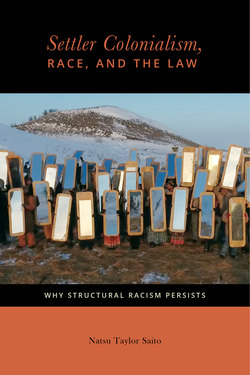Читать книгу Settler Colonialism, Race, and the Law - Natsu Taylor Saito - Страница 24
На сайте Литреса книга снята с продажи.
3 Settler Colonialism
ОглавлениеColonial subjugation and racial domination began much earlier and have lasted much longer in North America than in Asia and Africa, the continents usually thought of as colonial prototypes.
—Bob Blauner
Indigenous peoples have consistently recognized the impact of colonization on their communities, and in recent decades a strong body of scholarly analysis has emerged to address its ongoing manifestations.1 The situation of other peoples of color within the United States, however, is rarely discussed, much less theorized, in terms of colonialism.2 This was not always true. As noted in chapter 1, during the global “decolonization era” of the 1960s, powerful movements emerged in African American, American Indian, Chicano, Puerto Rican, and Asian American communities that identified themselves, to some degree or another, as internally colonized peoples, and it was not uncommon for scholars of color to also articulate this perspective.3 Since then, however, internal colonialism has come to be regarded as—at best—an empowering analogy rather than a framework for meaningful structural analysis, at least with respect to non-Indigenous peoples of color.4 The demise of the approach has been attributed to the systematic and violent repression of organizations and movements that framed their goals in terms of national liberation, as well as the (perhaps related) failure of mainstream social science to recognize it as a legitimate inquiry.5 These developments, however, tell us only that the depiction of “racial minorities” as colonized peoples is perceived as a threat to the status quo; they do not address the underlying question of the extent to which ongoing colonization accounts for structural racism in the United States today.
This was the question that led me to write this book. Did the construct of internal colonialism largely disappear from the discourse on race simply because of social and political repression or was the theory itself structurally flawed? Upon closer examination, I realized that most of the analyses invoking internal colonialism with respect to non-Indigenous peoples in the American context employ the lens of external or “classic” colonialism, as exemplified by European expansion into Africa and Asia. From this perspective, many parallels emerge between the histories and conditions of colonized peoples in Africa and Asia and people of color in the United States. But there are also many aspects of American racial hierarchy and exploitation that are not easy to account for within this paradigm. Viewing the United States as a different kind of colonial power, however, can fill in many of the narrative gaps that exist in each of these approaches.
While the United States has maintained external colonies, it is first and foremost a settler state.6 Settler colonialism is structurally distinct from classic external colonialism and, thus, it is not surprising that a model based upon external colonization has limited utility when applied to a settler state. Analyzing the histories of American Indians, African Americans, and other peoples of color in the United States through the lens of settler colonial theory can explain a great deal about our contemporary racial realities. In particular, we can see how structures of racial subordination have been employed strategically to consolidate the settler state and to enhance the wealth and power of the settler class. Chapters 4 through 8 explore those strategies in more detail. Establishing a framework for those explorations, this chapter provides an overview of the concept of colonialism and describes briefly what is meant by external or “classic” colonialism, internal colonialism, and settler colonialism. It concludes by acknowledging potential benefits and pitfalls of “triangulating” settler colonial analyses by distinguishing non-Indigenous peoples of color from the settler class.
